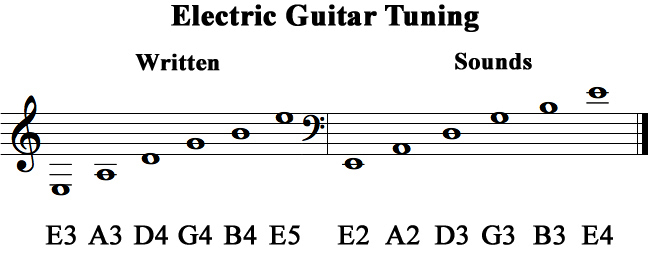electric guitar
ee-LEK-trik gih-TAR
[English]
HISTORY: The desire to increase the sound volume of the acoustic guitar existed long before the development of electronic amplifiers and speakers. As the musical performances in the 19th century grew to larger concert settings and ensembles, musicians needed louder instruments. New materials and instrument designs made this possible to some extent. The introduction of steel strings in the 19th century provided greater volume, but required major changes in the instrument's design to account for the increased tension of the string.
In the 20th century, public dance music became more popular and by the 1920's, the early recording equipment needed a relatively loud volume to capture a musical performance. By the end of the 1930s, electronic amplification proved to be one of the most successful innovations for building a louder guitar. It was clear that country and jazz guitarists were eager to experiment and were the leaders in the development of the electric guitar sounds. Several electric guitars were introduced and sold, but they still had problems (distortion, feedback, and unwanted overtones). The distortion was often due to the acoustic design of the guitars. The presence of a vibrating chamber (soundbox) or soundboard made it difficult to amplify these sounds without producing feedback or distortion. It became clear that the solid-body was the ideal design. The solid-body basically meant that the only vibrations being amplified are from the strings themselves. There are no other vibrations to distort or provide unwanted overtones. Although the first solid-body electric guitar commercially available was the 1939 Slingerland, it wasn't until 1949 when the first successful solid-body electric guitar was sold by Leo Fender. The guitar was called the Esquire and later was renamed Broadcaster and finally took the name of Telecaster.
Based on the success of the Esquire, the Gibson guitar Company went back to famed guitarist Les Paul and looked at his designs that he had been promoting for over 10 years. Finally, in 1952 Gibson came out with (what would eventually be) the famous Les Paul model solid-body electric guitar. By the 1960's, the electric guitar reached maturity with the introduction of the semi-hollow body electric guitar (used by B.B. King and Chuck Berry) and the Fender Stratocaster (used by Jimmy Hendrix). Few major innovations in electric guitar design have been made since then.
Other physical innovations to the electric guitar included a tremolo arm that allowed the performer to bend the pitch. Most of the other innovations were in the sounds of the electric guitar through the large advances in electronics.
Today, electric guitars are found in almost every popular musical ensemble, not just country and jazz. With advances in electronics, the electric guitar can easliy reproduce the sounds of an acoustic guitar as well as the high-energy sounds of rock and heavy metal.
PHYSICAL DESCRIPTION: The modern electric guitar is a solid-body instrument, visually similar to the acoustic guitar, but thinner. It has no soundbox and no vibrating soundboard. It has six strings just like the acoustic guitar. It has a long neck like a guitar and typically fretted. The six strings are held in place with the tailpiece at one end of the instrument and by the tuning pegs at the end of the neck. The tuning pegs are mechanical screws. An electrical pickup is positioned under the strings near the bridge and turns the vibrations of the strings into electrical impulses that are sent to an amplifier. A 1/4" phono plug in the body of the instrument is used to connect to the amplifier.
The electric guitar requires an amplifier to amplify the frequencies of the vibrating strings that are sensed by the pickup. The amplifier takes these signals and processes them into louder and often altered sounds that are then sent to a speaker so they can be heard. The amplifier and sound processors in the amplifier are what provides the range of sounds that make the electric guitar such a versatile instrument.
SOUND PROPERTIES: One of the biggest challenges of amplifying an acoustic guitar was the fact that the hollow body allowed for a great deal of resonance and vibrations from a number of sources (strings, soundbox, soundboard, etc.) are all amplified, often creating a jumbled sound. A solid-body has more mass and less vibration, so the pickup reproduces a cleaner signal of the pure vibrations of the strings. Since there is no acoustic resonator, the instrument's sounds are largely determined by the electronic amplifier and sound processors that it is connected to. The sounds range from a "pure" amplification of the strings (that can provide a sound similar to an acoustic guitar) to the distorted electronic sounds found in some heavy metal or rock music. These sounds can also be altered by the techniques of attacking the notes (striking, plucking or slapping the strings).
Guitar effects boxes, such as the fuzz box and the wah-wah have been a staple of the electric guitar's sounds for many years. Other colors and textures, like distortion, reverberation (reverb), feedback, using the electric guitar's tremolo arm and playing close to the amplifier are also common and allow musicians to alter, bend, and sustain notes.


